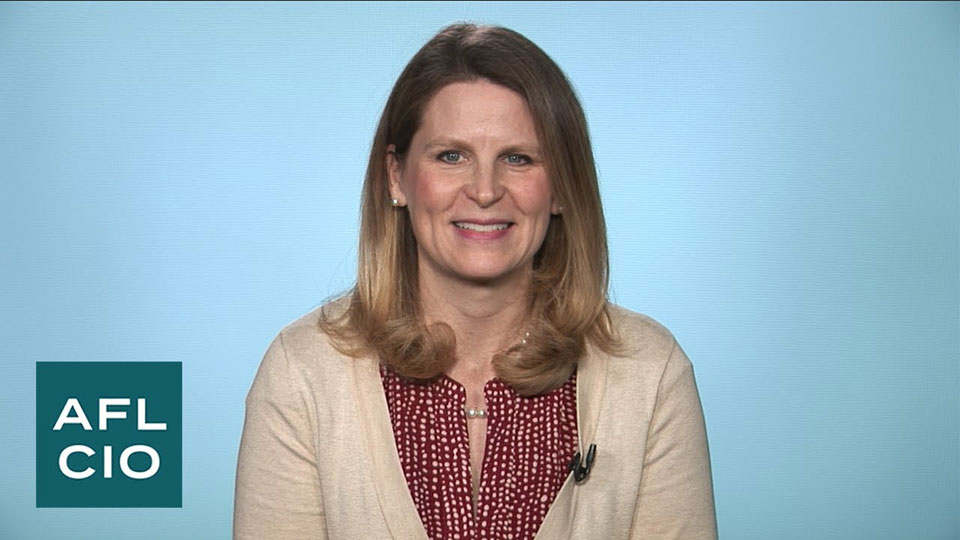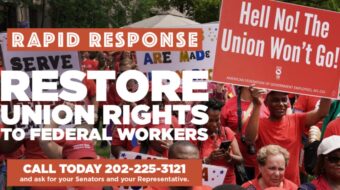
WASHINGTON—The yawning gap—and in many cases, a chasm—between rich company CEOs and the rest of us, especially their workers, is yet another reason Congress should pass the Protect the Right to Organize (PRO) Act, AFL-CIO Secretary-Treasurer Liz Shuler says.
And the labor federation will take that message, among others in favor of the legislation, on the road in a week-long on-the-ground grass-roots campaign from July 17-23. It’ll use data from its latest Executive Paywatch analysis, released July 14.
“On average, CEOs of S&P (Standard & Poors) top 500 companies were given a big raise” in 2020, she said. They received $15.5 million in total compensation. Compared to 2019, that’s a pay increase of more than $700,000, during the worst public health crisis in a century,” Shuler said in releasing the report, available at www.paywatch.org.
But as the corporate elite raked in more money, their workers, and especially their essential workers such as nurses, sanitation engineers, fast food workers, and apparel workers, didn’t. Which is why the PRO Act is absolutely needed, she declared.
“It’ll begin to tip the scales back” towards workers “before they break,” Shuler said.
The campaign is designed to both thank senators who are now co-sponsors of the legislation and target those who are opposed or on the fence. The PRO Act is the most wide-ranging pro-worker labor law proposal since the original National Labor Relations Act of 1935,
But the fed needs to push the needed three reluctant Senate Democrats—both Arizonans and Virginia’s Mark Warner—to add their names to it, in the 50-50 chamber.
Unionists won’t neglect the 50 Senate Republicans, whom their leader, Mitch McConnell, R-Ky., plans to use to kill the PRO Act via filibuster. The fed will put pressure on the GOP, too, via office visits, demonstrations, and other events.
But the filibuster threat means the AFL-CIO and its civic, civil rights, and Poor People’s Campaign allies, will also have to campaign to abolish the rule that permits such filibusters.
The latest Paywatch data, covering 2020 and taken from required federal reports, show the median pay for a CEO of a Fortune 500 firm was 299 times the median pay of all U.S. workers. That’s up from a 264-1 ratio in 2019.
“Some companies furloughed working people, then tried to make a big deal about cutting CEOs’ base salaries” during the coronavirus pandemic, Shuler said. “In reality, CEOs enjoyed big increases in their equity compensation. While CEO base salaries decreased slightly, the average S&P 500 company CEO’s stock-based pay increased by over $1 million. And that doesn’t even factor in the dramatic rise in the stock market in the second half of the year.
“As the Institute for Policy Studies recently pointed out, dozens of S&P 500 companies actually increased their CEO’s pay. Some companies gave ‘retention’ awards to their CEOs as their stock prices fell. Others changed” the standards they used to measure and set CEO pay to discount the coronavirus’s impact.
In most cases, they didn’t do so for their workers.
The result? Horrifying ratios of CEO to worker pay, especially in the apparel industry, but also one amazing case in Oklahoma City. There, Chad Richison, the founder in 1998 and CEO of Paycom Software, Inc., an online payroll and HR company, walked away with $211 million in pay, perks, stock option values, and bonuses in the firm’s latest fiscal year.
Richison’s take was the second-highest among all the execs in the Paywatch report and the highest figure in the U.S. It was also 2,963 times the pay of an average U.S. worker. His one figure made Oklahoma the state with the worst CEO-to-worker pay ratio in the U.S.
Topping Richison: Robert Antokol, CEO of Playtika, a digital entertainment company based in Herzliya, Israel. He made $372 million, 5,791 times the pay of an average U.S. worker. The report did not say if any of Playtika’s workers toil here.
The dishonor of the widest chasm between a CEO and workers went to Fran Horowitz, the CEO of Abercrombie & Fitch, the high-end apparel manufacturer, and retailer. She garnered $11.95 million, but since poorly paid overseas workers make all A&F clothes, her pay ratio to her employees was an eye-popping 6,565-1.
“The PRO Act will remove barriers to organizing, hold companies accountable for violating workers’ rights, and repeal ‘right to work’ laws that lead to lower wages for working people and their families,” Shuler noted.
In a new analysis in this year’s figures, the federation reported the CEO-to-worker pay ratio in the Russell 3000 set of companies—a much wider group of firms—also showed the difference between pay ratios in so-called “right to work” states and the other, more-unionized states. The ratio was 173-1 in RTW states, while it was 133-1 in other states, which allow unions to collect both dues from members and lower fees from represented non-members.










